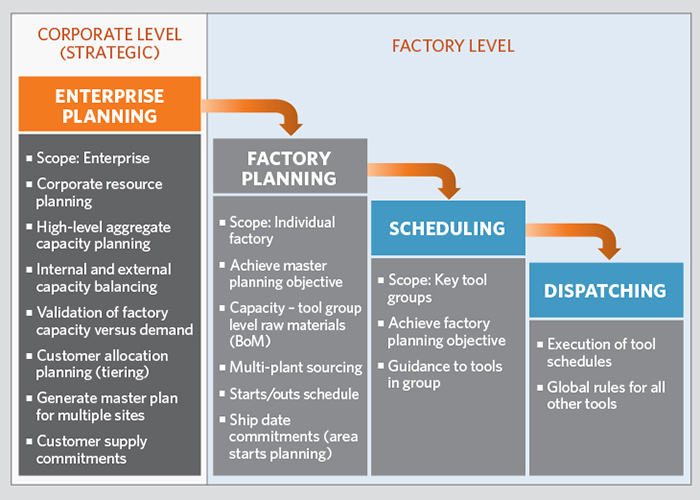Products & Technologies
Back to Menu
Products & Technologies
Services
Resources
Advanced Planning and Scheduling Solutions Boost Productivity
By Madhu Mamillapalli
Semiconductor manufacturing is a complex, capital-intensive business, yet many companies still use outdated planning techniques, such as spreadsheets and enterprise resource planning (ERP) systems, to manage production flow. In today’s environment, where many industries are struggling with chip shortages, semiconductor manufacturers need new ways to streamline their device production processes and wring higher productivity from their existing fabs. The Advanced Planning and Scheduling Solutions from Applied Materials are designed to do exactly that.
Semiconductor companies often operate globally, across multiple product segments, with a wide range of products. Product manufacturing lead times can be long, while order lead times may be short, and customer demand can shift quickly.
Supply-chain-planning teams are constantly under pressure to respond quickly and keep up with these highly variable conditions. Therefore it’s essential to create a good capacity plan and a schedule for executing the plan at the shop-floor level.
Traditional ERP systems are simply inadequate to meet the needs of the complex semiconductor industry. Here are the many challenges planners face:
- Comprehending complex manufacturing process
- More technologies resulting in increased parts mix
- Complex re-entrant process flows with a long bill of materials (BOM) list
- High equipment setup change penalties
- Choosing between multiple objectives
- Satisfying expedited orders and managing priority
- Managing cycle time and on time delivery to meet commit plan
- Maximizing the equipment utilization to increase throughput
- Flexibility
- Constant demand changes and backlogs resulting in multiple what-if scenarios
- Unstable attributes, including cycle times, yields, test times, other units per hour (UPH), and new product introduction (NPI) attributes
- Accuracy
- Predicting ship-out dates to commit plans to the customer
- Maintaining capacity balance in the factory
- Response time
- Customers demand faster response times and change order flexibility
- Ever increasing time and effort needed to manually create a supply plan
- Integration with systems
- Multiple data sources and data formats
- Lack of integration between planning and execution systems
- Stale data feeds
- Stability
- Architecture and framework require heavy resources
A CASE IN POINT
A large semiconductor backend assembly and test (AT) manufacturing facility faced many of these challenges. The company assembles and tests more than 50 million parts per month, across nearly 125 different products. The complexity encompasses different form factors, multiple levels of subparts, and a dizzying array of resources, raw materials, and alternate steps, all with varying parameters. Moreover, the operation is divided into different process areas serving different verticals, each acting as discrete entities, which limited the information flow between the areas.
These factors led to a very large planning model, causing planning commit cycles of a week or longer and increasingly inaccurate scheduling sequences. In turn this led to a decline in on-time delivery percentage. The company needed a fast and automated solution that could comprehend all the complexities and provide an optimized plan with a detailed scheduling sequence.
Applied Materials was able to resolve these challenges by deploying its Advanced Planning and Scheduling Solutions to generate a fast and accurate commit plan with a detailed lot-to-equipment level scheduling sequence and dispatch list.
The solution here was developed on Applied’s Advanced Productivity Family (APF) platform, which enables seamless integration between factory planning, scheduling and dispatching (figure 1). Developed solutions are specifically designed for the semiconductor industry and deployed as prepackaged, ready-to-use models with standard analytics and reports generated using Applied SmartFactory® EngineeredWorks.®

Figure 1. Applied’s Advanced Planning and Scheduling Solution provides a common framework from enterprise planning to dispatching built on the Applied APF platform and utilizing Applied SmartFactory® EngineeredWorks.®
Some of the key features of Applied’s Advanced Planning and Scheduling include:
- Automated input data generation. Master Planning’s automated input data generation and manipulation uses Applied APF technology to gather and load all necessary planning data. By using this capability, manufacturers can standardize all relative planning data and drive improvements in data quality. Less manual management of data leads to increased planner productivity.
- Fast planning engine. The planning engine includes a

mathematical solver that optimizes on-time delivery and other critical business objectives. The ability to quickly run the data generation and planning engine allows for fast "what if" scenario planning or re-planning, enabling quick response times to customer requests.
- Custom or standard reports. Master Planning supports planner analysis with standard supply planning reports through the Applied SmartFactory user interface. Additionally, customized reports may be created, including current output report formats that customers may require.
- Linking planning to execution. Using Applied SmartFactory, which includes factory planning, scheduling, and dispatching enables manufacturers to align their planning efforts with execution. This provides early warning capabilities if planned commitments cannot be achieved. While planning, scheduling, and dispatching are separate SmartFactory solutions, it is when all three are combined that productivity goes up sharply. For fabs to reach their goal of 100% utilization, the planning layer must be integrated with the execution layer to achieve the best output.
ARCHITECTURE DESCRIPTION
The architecture of Applied’s Advanced Planning and Scheduling Solutions was designed to provide an optimization-based plan combined with simulation to improve the accuracy of the commit plan and scheduling. The whole solution is segregated into two layers: planning and execution (figure 2). Planning is a more strategic layer whereas execution is the day-to-day operations, including actions to implement the plan.
- Planning Layer
Applied uses two iterations to calculate capacity in order to enhance the accuracy of the plan. The first iteration is Master Planning, which checks the capacity and generates an optimized starts-and-outs plan. The solution uses a fast and sophisticated mathematical solver that optimizes the plan based on the customer-defined objective functions. To further improve planning accuracy, the optimized output from Master Planning is fed into Factory Planning, which is the second iteration in the Planning layer. Factory planning validates Master Planning using the simulation model to derive an accurate commit plan for the manufacturer’s customer.
- Execution Layer
The output of the planning is then fed into Scheduling, which uses Applied AutoSched® for simulation to generate a detailed lot-to-equipment level sequence. This sequence is ultimately used to generate a real-time dispatching list for each station. The Scheduling and Dispatching functions in the execution layer play a vital role in ensuring that the plan is being implemented at the shopfloor level and achieves the goals set at the planning level.

Figure 2. Applied’s Advanced Planning and Scheduling data-flow architecture consists of a planning and an execution layer.
Output
The output from Applied’s Advanced Planning and Scheduling Solutions was helpful in quickly identifying bottlenecks and material shortages. The simulation model aided in planning equipment setups in advance. It also predicted future bottlenecks and inefficiencies by visualizing the flow in the user interface (UI). Planners were able to run multiple what-if scenarios and see those plans executed quickly at the shop-floor level.
Results
The solution’s performance was stable and had a fast run time, reducing the manufacturer’s overall planning duration by 75%. All the functions were automated with real-time data feeds and error checks, improving the plan accuracy and planner productivity by more than 30%.
Conclusion
In today’s semiconductor industry it is increasingly important to adopt more robust planning systems, such as Applied’s Advanced Planning and Scheduling Solutions. Traditional spreadsheets and ERP systems are simply not capable of handling the increased complexity and variable demand.
Implementing multiple functions and running iterations for validation are necessary to create an accurate plan. Applied was able to design the Advanced Planning and Scheduling Solutions to improve the AT manufacturer’s factory KPIs for on-time delivery, utilization, and planner productivity, while also maintaining high plan accuracy and fast performance.

